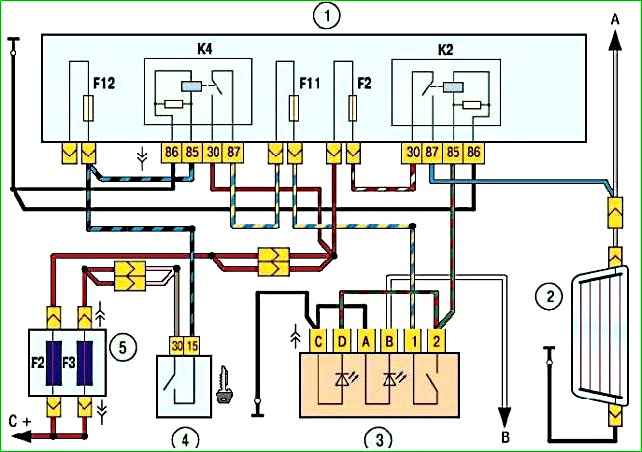The diagram of the rear window heating system is shown in Fig. 1.
The rear window heating element is switched on by relay K2, installed in the mounting block.
To prevent the battery from being discharged by the heating element left on when the engine is not running, the heating can only be switched on when the ignition is on.
For this purpose, power is supplied to switch 3 via an additional relay (ignition relay) K4, which is triggered when the ignition is turned on, and fuse F11.
Power is supplied to the heating element via fuse F2 in the mounting block located in the vehicle interior.

If the rear window is not heated when the heating is turned on, check fuses F2 and F11 in the fuse box, fuse F2 in the main fuse box, wires and their connections, switch and relay K2.
If all fuses, relays and the heating element power supply circuit are in good condition, check the serviceability of the conductive strips.
The test is carried out with the engine running and the rear window heating turned on.
Use a voltmeter to measure the voltage on all strips one by one, connecting one terminal of the voltmeter to the body ground and the other in series to the conductive strips.
If the voltage measured by the voltmeter at the beginning and end of the strips is the same and approximately equal to the battery voltage, check the reliability of the contact of the heating element ground wire with the car body.
Voltage on the strip should decrease as the voltmeter connection point moves away from the positive polarity bus of the element.
The voltage must be measured in at least two places at the same distance from the axis of symmetry to eliminate the possibility of missing a damaged area.
If you find a discrepancy in the readings on one of the strips, move the contact of the voltmeter wire along this strip until the voltage becomes zero.
A sharp drop in voltage indicates a break in the strip in this place.
Mark the break on the outer surface of the glass with chalk or a glass graphite pen for subsequent repair of the damaged area.
You can use one of the special kits available for sale that contain silver to repair the heating element.
Despite the fact that the kits are made by different manufacturers, their composition is approximately the same, all kits are supplied with instructions for use.
Below is a typical procedure for working with these sets
- 1. Remove a 6 mm section of the strip from each side of the damaged area.
- 2. Wipe the damaged area with a clean cloth soaked in alcohol.
- 3. Stick repair adhesive tape or two pieces of regular adhesive tape on the glass at the damaged strip location above and below the area to be repaired, with the distance between the pieces of adhesive tape corresponding to the width of the conductive strip on the glass.
- 4. Mix the hardener thoroughly with the silver-colored base composition.
If the hardener has thickened, place the package with it in hot water and wait until the hardener becomes liquid.
- 5. Apply the composition to the area to be repaired with a wooden spatula and remove the adhesive tape.
- 6. Place the heater at a distance of 25 mm from the damaged area and heat the composition for 1–2 minutes. The minimum heating temperature is 149°C.
Some kits do not require heating the composition: it polymerizes at room temperature.
- 7. If the strip becomes discolored after drying, apply a tinting iodine composition to it with a brush — the color of the strip will be restored. After the iodine composition dries for 30 seconds, wipe off its excess with a clean, lint-free cloth.
During the polymerization of the repair composition, which lasts 24 hours, avoid any mechanical impact on the repaired section of the strip.
- 8. Turn on and check the operation of the rear window heating element.
If the wire has come off the bus, solder it with solder containing 3% silver and rosin paste as a flux, in the following order:
- 1. Clean the soldering area on the bus and the wire core.
- 2. Apply the soy the connecting parts of the wire and the busbar a little rosin paste.
- 3. Apply a thin layer of solder to the wire core.
- 4. Solder the wire to the busbar, avoiding overheating the parts being connected.





